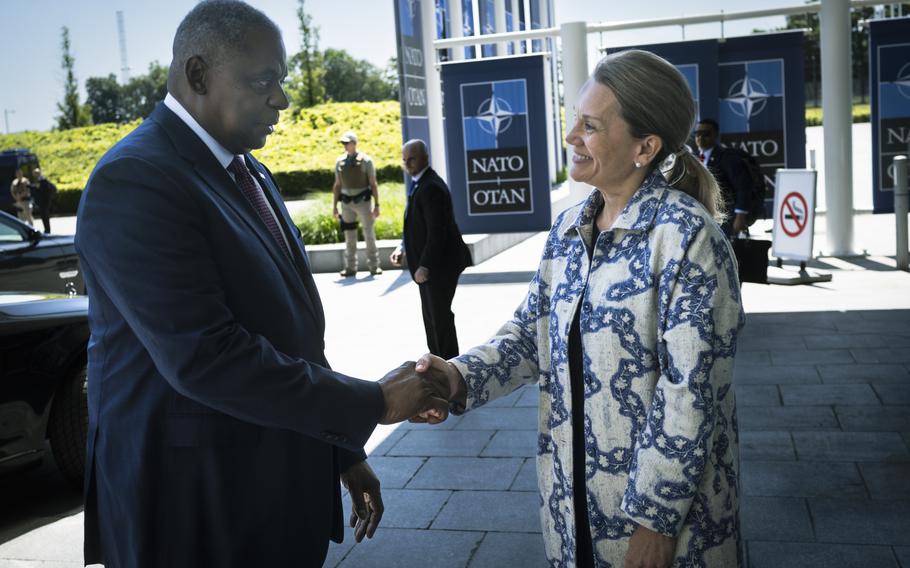
U.S Ambassador to NATO Julianne Smith greets Defense Secretary Lloyd Austin in June 2022 for a meeting of the Ukraine Defense Contact Group at NATO headquarters in Brussels, Belgium. (Chad J. McNeeley/Department of Defense)
WASHINGTON — The number of NATO members meeting the military alliance’s defense spending benchmark could reach 23 nations this year — an all-time high prompted by the war in Ukraine, the U.S. permanent representative to NATO said Monday.
Ambassador Julianne Smith estimated about 20 nations out of the alliance’s 32 members would spend at least 2% of their gross domestic product, or total economic output, on their militaries a decade after pledging to do so.
“We think we’re going to be somewhere around 20, 21, 22, possibly 23 allies hitting the 2% mark,” Smith told reporters at a Defense Writers Group event. “That is leaps and bounds from where we started 10 short years ago.”
NATO will release a final number in a report later this month, ahead of a July summit in Washington, D.C., marking the alliance’s 75th anniversary.
Only three member nations spent 2% of their GDP on defense in 2014, when the expenditure goal was set. That number ticked up to seven allies in 2022, the year that Russia launched its full-scale invasion of Ukraine.
Smith said burden-sharing in the mutual-defense alliance will be a top topic of discussion at the July gathering as Russia’s war in Ukraine drags on for a third year, and the U.S. continues to bear much of the burden for Europe’s defense.
The issue is particularly fraught in an election year that could return former President Donald Trump to the White House. Trump has said he would let Russia “do whatever the hell they want” to NATO allies that do not fulfill their military spending obligations, inflaming concerns that the U.S. could abandon the alliance it helped found after World War II.
Smith said Europeans are watching the U.S. presidential election “very carefully” and trying to imagine an array of scenarios depending on who wins. But they are also cognizant of the fact that talk on the campaign trail does not always translate to official policy, she said.
“Right now, the allies feel like the focus needs to be on Ukraine, the situation on the battlefield,” Smith said.
Russia took advantage of a lull in U.S. weapon shipments to seize additional territory in northeastern Ukraine in recent months and an alarming buildup of Russian forces in the region has raised fears that a new offensive is imminent.
Ukraine is eager to secure membership in NATO for protection, though that is unlikely while Russia wages war. Article 5 of the alliance’s treaty declares an attack against one member state is an attack against them all.
Smith said she does not expect allies to put a proper invitation on the table for Ukraine at the July summit.
Instead, the alliance will put forward a “package of deliverables that will serve as a bridge to their membership,” including “language we use to describe Ukraine’s membership aspirations,” she said.
The move is expected to frustrate Ukrainian President Volodymyr Zelenskyy, who is planning to attend the summit. Zelenskyy lashed out ahead of last year’s NATO summit, saying it was “unprecedented and absurd” that a timeline has not been set for Ukraine’s invitation to the alliance or its membership.
NATO has grown to include Finland and Sweden since Russia’s invasion of Ukraine, with both countries rejecting decades of neutrality to join. Finland announced plans to spend 2.3% of its GDP on defense this year, and an influential Swedish parliamentary committee said Sweden should spend 2.6% of its GDP on its military by 2030.
Most NATO members should be able to meet the 2% target spending threshold in the next three years, Smith said. Some, most vocally Poland, are calling on the alliance to increase the benchmark to 2.5% or 3% of GDP in preparation for a prolonged confrontation with Russian aggression.